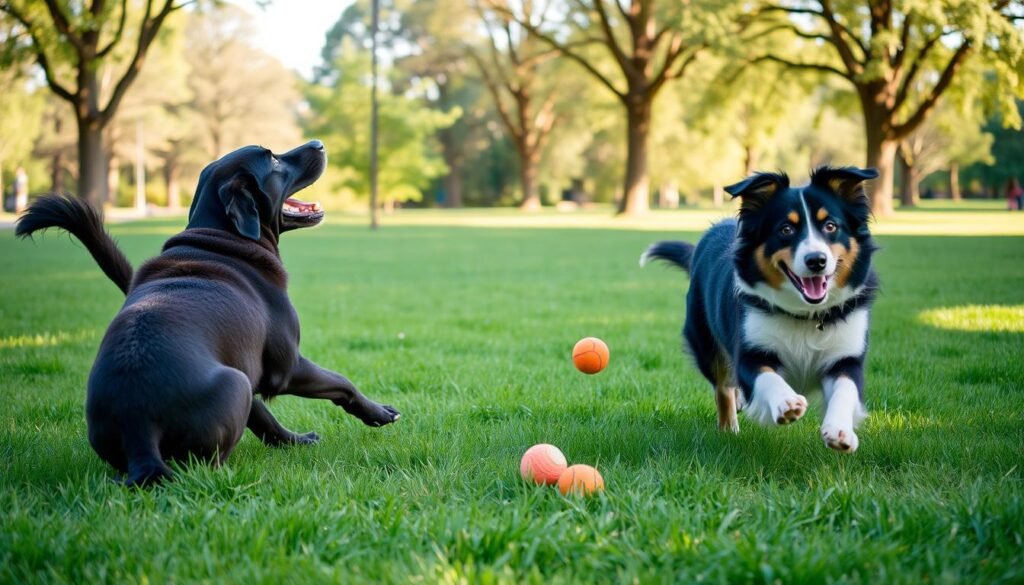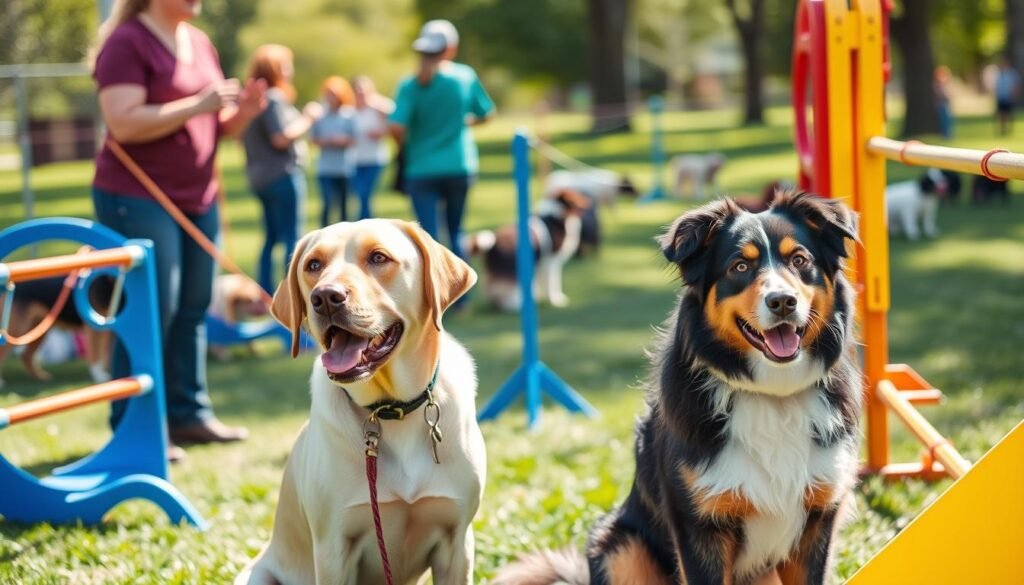Labrador Retrievers vs Australian Shepherds: A Comparison
Did you know Labrador Retrievers have been America’s favorite dog since 1991? This fact shows how much people love these friendly dogs. But how do they compare to the Australian Shepherd?
Choosing between these two breeds, pet owners consider their unique qualities. Labradors are known for their happy nature and retrieving skills. Australian Shepherds, on the other hand, are hardworking and adaptable, bred for herding.
Both breeds are great with families, but they have different needs. Knowing about size, temperament, exercise, and grooming is key for pet owners.
In this comparison, you’ll see how Labradors are bigger and heavier than Australian Shepherds. We’ll look at their temperaments, exercise needs, and how they fit into different lifestyles. This guide will help you decide between a retriever or a herding dog.
Key Takeaways
- Labrador Retrievers have been America’s favorite dog breed since 1991
- Australian Shepherds are generally smaller and lighter than Labradors
- Both breeds are family-friendly but have different exercise needs
- Labradors excel in retrieving, while Aussies have strong herding instincts
- Understanding each breed’s characteristics is crucial for choosing the right pet
Overview of Labrador Retrievers
Labrador Retrievers are loved by many families for their friendly and versatile nature. They have a rich history and unique traits that set them apart from other breeds.
History and Origin
Labrador Retrievers come from the Canadian province of Newfoundland. They were originally bred for fishing in the 1880s. But, they almost disappeared due to laws and taxes. Now, they are America’s favorite dog since 1991.
Physical Characteristics
Labrador Retrievers are big and strong with a unique look. They are 21.5 to 24.5 inches tall and weigh 55 to 80 pounds. Their short, dense coat is in three colors: black, yellow, and chocolate.
| Characteristic | Details |
|---|---|
| Average Height | 21.5 inches |
| Average Weight | 67.5 pounds |
| Lifespan | 11.5 years |
| Exercise Needs | 1+ hours daily |
| Grooming | Moderate |
Temperament and Personality
Labrador Retrievers are known for being friendly and outgoing. They are smart and love to please, making them great family pets. They are also excellent as assistance and therapy dogs because of their intelligence and good nature. Their love for people and pets makes them perfect for active families.
If you want a loyal, energetic, and loving dog, a Labrador Retriever is a great choice. These dogs love being around people and are always up for an adventure.
Overview of Australian Shepherds
Australian Shepherds, despite their name, have roots in the American West. These herding dogs have become popular family pets because of their smarts and loyalty. Let’s dive into the world of Aussies.
History and Origin
Despite their name, Australian Shepherds actually come from California, not Australia. They were first bred as sheepdogs in the 1840s. The American Kennel Club recognized them as a breed in 1991, making them well-known in the dog world.
Physical Characteristics
Australian Shepherds are medium-sized dogs with a strong build. They usually grow 18-23 inches tall and weigh 40-65 pounds. They have a beautiful, weather-resistant double coat in many colors and patterns.

Temperament and Personality
Australian Shepherds are known for their high energy and smarts. They make great friends for active families. They love to please and are easy to train. However, their herding instinct can sometimes lead them to herd children or other pets, which can be funny and challenging.
| Trait | Description |
|---|---|
| Intelligence | Highly intelligent, quick learners |
| Energy Level | High, requires 1-2+ hours of daily exercise |
| Trainability | Excellent, responds well to positive reinforcement |
| Lifespan | 12-15 years |
| Grooming Needs | Moderate, regular brushing required |
Key Differences in Appearance
When we look at dog breeds like Labrador Retrievers and Australian Shepherds, their looks are key. Let’s dive into what makes them different.
Size and Build
Labrador Retrievers are bigger than Australian Shepherds. Labs are 21.5-24.5 inches tall and weigh 55-80 pounds. Aussies are a bit smaller, at 18-23 inches tall and 40-65 pounds.
Both breeds are built strong and athletic. This is because of their work backgrounds.
Coat Colors and Types
Labs have a short, dense coat in black, yellow, or chocolate. Australian Shepherds have a medium-length coat with more color options. Their coats can be blue merle, black tri, red merle, or red tri.
Their coats are straight to wavy. This helps them handle the weather.
Eye Characteristics
Eye color is a big difference between these breeds. Labs usually have brown eyes. Australian Shepherds can have brown, blue, amber, or even mixed colors.
| Characteristic | Labrador Retriever | Australian Shepherd |
|---|---|---|
| Height | 21.5-24.5 inches | 18-23 inches |
| Weight | 55-80 pounds | 40-65 pounds |
| Coat Length | Short | Medium |
| Coat Colors | Black, Yellow, Chocolate | Blue merle, Black tri, Red merle, Red tri |
| Eye Colors | Brown | Brown, Blue, Amber, or combinations |
Temperament Comparison
Choosing a family dog means understanding their temperament. Labrador Retrievers and Australian Shepherds are both friendly. Yet, they have different personalities that fit various lifestyles.
Family Compatibility
Labradors are great with families. They’re kind, outgoing, and patient with kids. They also get along well with other pets and strangers.
Australian Shepherds are friendly too. But, they might try to herd family members because of their herding instinct.
Energy Levels
Australian Shepherds need lots of exercise, 1-2+ hours a day. They love playing Frisbee and going on long walks. Labradors need about 1+ hour of exercise daily, making them more flexible for different schedules.
Trainability
Both breeds are easy to train, perfect for families wanting obedient pets. Labradors are quick learners and often become guide dogs. Australian Shepherds are smart and love to solve complex tasks because of their herding background.
| Trait | Labrador Retriever | Australian Shepherd |
|---|---|---|
| Family Compatibility | Excellent | Good |
| Energy Level | Moderate to High | High |
| Trainability | Highly Trainable | Highly Trainable |
| Exercise Needs | 1+ hours daily | 1-2+ hours daily |
| Sociability | Very Social | Cautious with Strangers |

Choosing between these breeds depends on your family’s lifestyle and activity level. Both are great pets but fit different homes better.
Grooming Needs
Dog grooming is key to keeping your pet healthy and looking good. Labrador Retrievers and Australian Shepherds need different grooming care. It’s important for owners to know these needs.
Coat Maintenance for Labradors
Labradors have a double coat that sheds a lot, especially in certain seasons. Brush them every day during these times to keep their coat in top shape. They should be bathed every four to six weeks, or more often when they shed a lot.
Trim their nails every three to four weeks. Also, keep their paws trimmed well for their foot health.
Coat Maintenance for Australian Shepherds
Australian Shepherds have a longer coat that needs more grooming. Brush your Aussie several times a week to avoid mats and tangles. In summer, trim their undercoat but leave the top coat.
Shedding and Allergies
Both breeds shed a lot, especially when the seasons change. Labs shed twice a year in big handfuls, while Aussies shed all year. Neither breed is good for people with allergies.
Regular brushing and baths can help manage their shedding. This can also reduce allergens in your home.
| Grooming Task | Labrador Retriever | Australian Shepherd |
|---|---|---|
| Brushing Frequency | Daily during shedding | 2-3 times per week |
| Bathing Frequency | Every 4-6 weeks | As needed |
| Nail Trimming | Every 3-4 weeks | Every 4-6 weeks |
Exercise Requirements
Labradors and Australian Shepherds both have lots of energy. They need regular exercise to stay healthy and happy. Knowing what they need helps make sure they get enough physical activity.
Ideal Activities for Labradors
Labradors do well with activities that are not too hard. They need 30 minutes to an hour of exercise every day. Swimming, playing fetch, and going for brisk walks are great for them. Their friendly nature makes them perfect for family activities.
Ideal Activities for Australian Shepherds
Australian Shepherds need more challenging activities. They need 1-2 hours of exercise daily to keep their body and mind healthy. Playing frisbee, doing agility courses, and herding are excellent choices. They also love obedience training as a way to keep their minds sharp.
Impact of Exercise on Behavior
Exercise is key for both breeds to avoid bad behavior. Without enough, they might get restless or anxious. Exercise keeps their minds and bodies healthy, preventing obesity and heart disease.
| Breed | Exercise Time | Ideal Activities | Energy Level |
|---|---|---|---|
| Labrador Retriever | 30-60 minutes | Swimming, fetch, walks | Moderate |
| Australian Shepherd | 1-2 hours | Frisbee, agility, herding | High |

Keep an eye on your dog’s signs of tiredness during exercise. If they pant too much, lag behind, or don’t want to keep going, it’s time to slow down or stop. Adjust their exercise routine based on their age and needs for their best health and happiness.
Health Considerations
When thinking about getting a Labrador Retriever or an Australian Shepherd, it’s important to know about their health needs. Both breeds have special health concerns that can affect their lifespan and happiness.
Common Health Issues in Labradors
Labradors can face some health problems. They might get hip dysplasia, which can cause arthritis, and they can also get too fat because they love to eat. Keeping them active and on a healthy diet is essential for their health.
Common Health Issues in Australian Shepherds
Australian Shepherds have their own health issues. Like Labradors, they can get hip dysplasia. They’re also at risk for eye problems like cataracts and Collie Eye Anomaly. Some Aussies might have a bad reaction to certain medicines.
Lifespan Expectations
The lifespan of these breeds is a bit different. Labradors usually live between 10-13 years. Australian Shepherds can live a bit longer, from 12-15 years. Taking your dog to the vet regularly and keeping them healthy can help them live a long life.
| Breed | Common Health Issues | Average Lifespan |
|---|---|---|
| Labrador Retriever | Hip dysplasia, Obesity, Joint problems | 10-13 years |
| Australian Shepherd | Hip dysplasia, Eye problems, Multiple Drug Sensitivity | 12-15 years |
Early detection and prevention are key to managing these health issues. Regular vet visits, the right food, and enough exercise can greatly improve your dog’s life and might even make them live longer.
Training and Socialization
Training and socialization are vital for raising well-behaved dogs. Both Labradors and Australian Shepherds need early and consistent training. Let’s look at the best training methods for each breed and why socialization is important.
Best Training Methods for Labradors
Labradors do well with positive reinforcement. Their playful nature and love for food make them eager to learn. Use treats and praise to reward good behavior.
Keep training sessions fun and engaging. Labs learn new commands quickly, making them great for first-time dog owners.
Best Training Methods for Australian Shepherds
Australian Shepherds love mental challenges. They are problem-solvers who need complex tasks to stay engaged. Incorporate agility training, puzzle toys, and advanced obedience work.
Aussies respond well to consistency and firm leadership. Their high energy levels need daily physical and mental exercise to prevent destructive behaviors.
Importance of Early Socialization
Socialization is key for both breeds. Expose your puppy to various people, animals, and environments early. This prevents fear and aggression issues later.
Take your dog to puppy classes, dog parks, and on outings. This builds confidence. Well-socialized dogs are friendlier and more adaptable in different situations.

| Training Aspect | Labrador Retriever | Australian Shepherd |
|---|---|---|
| Learning Style | Quick learners, food-motivated | Intelligent problem-solvers |
| Best Motivation | Treats and praise | Mental challenges and tasks |
| Exercise Needs | Daily walks and play | Intense physical and mental workouts |
| Socialization Focus | Meeting new people and dogs | Exposure to various environments |
Remember, consistency is key in dog training. Start early and make it a positive experience for your furry friend. With patience and the right approach, both Labradors and Australian Shepherds can become well-mannered companions.
Family Suitability
Choosing the right family dog is key for a happy home. Both Labrador Retrievers and Australian Shepherds are great for families. But, they fit different lifestyles better.
Labradors as Family Pets
Labradors are perfect for families with young kids. They are patient and gentle, making great playmates. They also get along well with other pets, making them a good choice for homes with many animals.
Australian Shepherds in Family Homes
Australian Shepherds are best for active families, especially those with older kids or teens. They need lots of exercise and mental challenges. They might try to herd small kids or pets, so early training is important.
Compatibility with Children and Other Pets
Both breeds need to be watched around young kids because of their size and energy. Early socialization helps them get along with other pets. Here’s a guide for choosing the right breed for your family:
| Family Type | Recommended Breeds |
|---|---|
| Young Children | Labrador Retriever, Golden Retriever, Beagle |
| Teenagers/Adults | Border Collie, German Shepherd, Australian Shepherd |
| Active Families | Siberian Husky, Belgian Malinois, Vizsla |
| Less Active Families | French Bulldog, Shih Tzu, Cavalier King Charles Spaniel |
When picking between Labradors and Australian Shepherds, think about your family’s lifestyle. Consider your activity level, home size, and training time. Both breeds can be great family pets with the right care.
Cost of Ownership
Thinking about getting a Labrador Retriever or Australian Shepherd? It’s key to know the costs. The expenses can differ a lot between breeds, impacting your budget over time.
Initial Purchase Price
The cost of a Labrador Retriever can range from $650 to $4,000. This depends on the dog’s lineage and the breeder’s reputation. Australian Shepherds might cost the same. Adopting from a shelter can save you money.
Ongoing Care Expenses
Every year, dog owners spend about $2,500 on their pets. This includes food, vet visits, and grooming. Big dogs like Labradors and Australian Shepherds might cost more. Vet bills can also vary, with some breeds needing more care.
Budgeting for Training and Supplies
Don’t forget the one-time costs of around $2,100 for things like crates and spaying/neutering. Both breeds need professional training, which adds to the cost. Remember to budget for ongoing needs like toys and bedding.
| Expense Category | Average Cost |
|---|---|
| Annual Food | $446 |
| Annual Vet Care | $423 |
| Annual Grooming | $190 |
| Annual Travel | $279 |
While the costs might seem steep, 68% of dog owners say they meet their expectations. With good budgeting, you can handle the financial side of owning a Labrador or Australian Shepherd.
Conclusion: Which Breed is Right for You?
Choosing a dog breed is a big decision that affects your family’s life. Both Labrador Retrievers and Australian Shepherds are great for families. Your lifestyle is key in picking the right breed for your home.
Lifestyle Considerations
If you enjoy outdoor activities, both breeds might be a good fit. Labradors love water and need lots of space. Australian Shepherds are perfect for high-energy tasks like agility training.
If you don’t have much time for exercise, consider breeds like Basset Hounds or Bulldogs. They need less activity.
Final Thoughts on Both Breeds
Labradors are friendly and patient, making them perfect for families with kids or other pets. They’re also great for first-time dog owners. Australian Shepherds are smart and energetic, best for experienced owners who can handle their high activity level.
Making the Best Choice for Your Family
Consider your living space, time for training, and grooming needs when choosing a breed. Labradors have short coats that need less grooming. Australian Shepherds require more coat care.
Both breeds can be loyal and loving family members with the right care and training.

